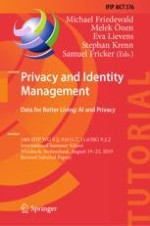This book contains selected papers presented at the 14th IFIP WG 9.2, 9.6/11.7, 11.6/SIG 9.2.2 International Summer School on Privacy and Identity Management, held in Windisch, Switzerland, in August 2019.
The 22 full papers included in this volume were carefully reviewed and selected from 31 submissions. Also included are reviewed papers summarizing the results of workshops and tutorials that were held at the Summer School as well as papers contributed by several of the invited speakers. The papers combine interdisciplinary approaches to bring together a host of perspectives, which are reflected in the topical sections: language and privacy; law, ethics and AI; biometrics and privacy; tools supporting data protection compliance; privacy classification and security assessment; privacy enhancing technologies in specific contexts.
The chapters "What Does Your Gaze Reveal About You? On the Privacy Implications of Eye Tracking" and "Privacy Implications of Voice and Speech Analysis - Information Disclosure by Inference" are open access under a CC BY 4.0 license at link.springer.com.
